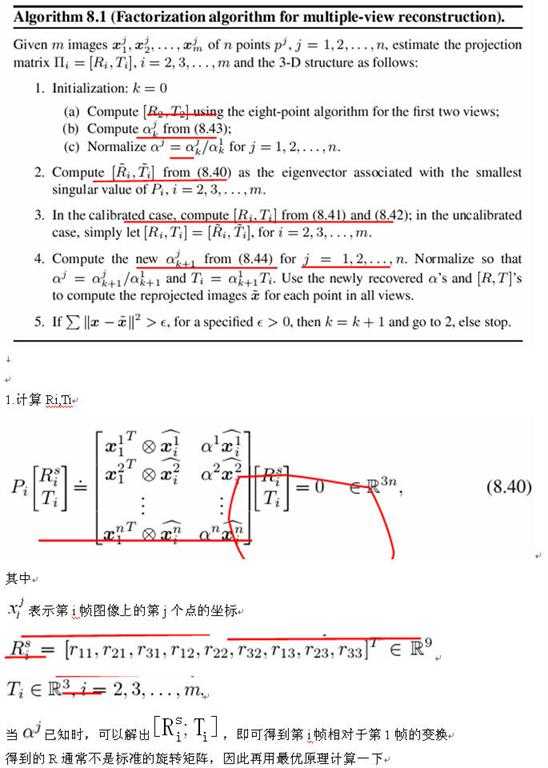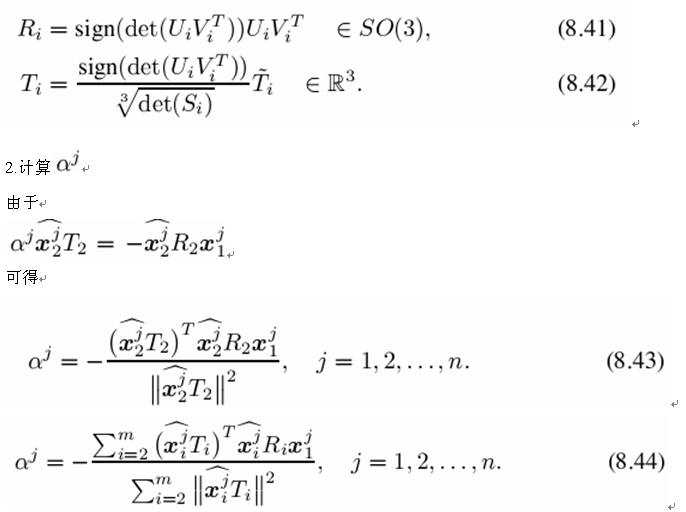标签:
这里采用的是Yi Ma , Stefano Soatto. An Invitation to 3-D Vision , From Images to Geometric Models 的算法


 %// Algorithm 8.1. also 11.7
%// Algorithm 8.1. also 11.7 %// Rank based factorization algorithm for multiview reconstruction
%// Rank based factorization algorithm for multiview reconstruction  %// using point features
%// using point features  %// as described in Chapter 8, "An introduction to 3-D Vision"
%// as described in Chapter 8, "An introduction to 3-D Vision" %// by Y. Ma, S. Soatto, J. Kosecka, S. Sastry (MASKS)
%// by Y. Ma, S. Soatto, J. Kosecka, S. Sastry (MASKS) %// Code distributed free for non-commercial use
%// Code distributed free for non-commercial use %// Copyright (c) MASKS, 2003
%// Copyright (c) MASKS, 2003
 %// Generates multiple synthetic views of a house and computes the
%// Generates multiple synthetic views of a house and computes the  %// motion and structure, calibrated case, point features only
%// motion and structure, calibrated case, point features only %// Jana Kosecka, George Mason University, 2002
%// Jana Kosecka, George Mason University, 2002 %// ======================================================================
%// ======================================================================
 close all; clear;
close all; clear; FRAMES = 3;
FRAMES = 3; PLOTS = 3;
PLOTS = 3; %// transformation is expressed wrt to the camera frame
%// transformation is expressed wrt to the camera frame
 Zinit = 5;
Zinit = 5;
 %// cube in the object frame
%// cube in the object frame XW = [0 1 1 0 0 1 1 0 0.2 0.8 0.2 0.8 ;
XW = [0 1 1 0 0 1 1 0 0.2 0.8 0.2 0.8 ; 0 0 1 1 0 0 1 1 1.5 1.5 1.5 1.5;
0 0 1 1 0 0 1 1 1.5 1.5 1.5 1.5; 1 1 1 1 0 0 0 0 0.8 0.8 0.2 0.2 ;
1 1 1 1 0 0 0 0 0.8 0.8 0.2 0.2 ; 1 1 1 1 1 1 1 1 1 1 1 1];
1 1 1 1 1 1 1 1 1 1 1 1];
 NPOINTS = 12;
NPOINTS = 12; 
 XC = zeros(4,NPOINTS,FRAMES);
XC = zeros(4,NPOINTS,FRAMES);
 %// initial displacement摄像机的初始位置
%// initial displacement摄像机的初始位置 Rinit = rot_matrix([1 1 1],0);
Rinit = rot_matrix([1 1 1],0); 
 Tinit = [ Rinit(1,:) -0.5 ;
Tinit = [ Rinit(1,:) -0.5 ; Rinit(2,:) -0.5 ;
Rinit(2,:) -0.5 ; Rinit(3,:) Zinit;
Rinit(3,:) Zinit; 0 0 0 1];
0 0 0 1]; %// first camera coodinates
%// first camera coodinates  XC(:,:,1) = Tinit*XW;
XC(:,:,1) = Tinit*XW;
 %//画出三维的结构 original motion and 3D structure
%//画出三维的结构 original motion and 3D structure figure; hold on;
figure; hold on; plot3_struct(XC(1,:,1),XC(2,:,1),XC(3,:,1));
plot3_struct(XC(1,:,1),XC(2,:,1),XC(3,:,1)); plot3(XC(1,:,1),XC(2,:,1),XC(3,:,1),‘*‘);
plot3(XC(1,:,1),XC(2,:,1),XC(3,:,1),‘*‘); draw_frame_scaled([diag([1,1,1]), zeros(3,1)],0.5);
draw_frame_scaled([diag([1,1,1]), zeros(3,1)],0.5); title(‘original motion and 3D structure‘);
title(‘original motion and 3D structure‘); view(220,20);
view(220,20); grid on; axis equal;
grid on; axis equal; %// axis off;
%// axis off; pause;
pause;

 %// image coordinates 计算第一帧时的图像坐标
%// image coordinates 计算第一帧时的图像坐标 xim(:,:,1) = project(XC(:,:,1));
xim(:,:,1) = project(XC(:,:,1));
 Zmax = max(XC(3,:,1));
Zmax = max(XC(3,:,1)); Zmin = min(XC(3,:,1));
Zmin = min(XC(3,:,1)); rinc = pi/30;
rinc = pi/30; rot_axis = [1 0 0; 0 -1 0]‘;
rot_axis = [1 0 0; 0 -1 0]‘; trans_axis = [1 0 0; 0 1 0]‘;
trans_axis = [1 0 0; 0 1 0]‘;
 ratio = 1;
ratio = 1; rinc = 10; %// rotation increment 20 degrees
rinc = 10; %// rotation increment 20 degrees Zmid = (Zmax+Zmin)/2;
Zmid = (Zmax+Zmin)/2; tinc = 0.5*ratio*Zmid*rinc*pi/180;
tinc = 0.5*ratio*Zmid*rinc*pi/180;
 ploting = 1;
ploting = 1;
 for i=2:FRAMES %//计算第i帧的图像坐标xim
for i=2:FRAMES %//计算第i帧的图像坐标xim theta = (i-1)*rinc*pi/180;
theta = (i-1)*rinc*pi/180; r_axis = rot_axis(:,i-1)/norm(rot_axis(:,i-1));
r_axis = rot_axis(:,i-1)/norm(rot_axis(:,i-1)); t_axis = trans_axis(:,i-1)/norm(trans_axis(:,i-1));
t_axis = trans_axis(:,i-1)/norm(trans_axis(:,i-1)); trans = (i-1)*tinc*t_axis;
trans = (i-1)*tinc*t_axis; R = rot_matrix(r_axis,theta);
R = rot_matrix(r_axis,theta); %// translation represents origin of the camera frame
%// translation represents origin of the camera frame %// in the world frame
%// in the world frame  T(:,:,i) = ([ R trans;
T(:,:,i) = ([ R trans; 0 0 0 1]);
0 0 0 1]); %// all transformation with respect to the object frame
%// all transformation with respect to the object frame XC(:,:,i) = T(:,:,i)*XC(:,:,1); %// XW;
XC(:,:,i) = T(:,:,i)*XC(:,:,1); %// XW; draw_frame_scaled(T(1:3,:,i),0.5);
draw_frame_scaled(T(1:3,:,i),0.5);  xim(:,:,i) = [XC(1,:,i)./XC(3,:,i); XC(2,:,i)./XC(3,:,i);
xim(:,:,i) = [XC(1,:,i)./XC(3,:,i); XC(2,:,i)./XC(3,:,i); 
 ones(1,NPOINTS)];
ones(1,NPOINTS)]; end;
end;
 for j = 2:FRAMES
for j = 2:FRAMES T_ini(:,j) = T(1:3,4,j);
T_ini(:,j) = T(1:3,4,j); end;
end;
 %// noise can be added here
%// noise can be added here for i=1:FRAMES
for i=1:FRAMES  xim_noisy(:,:,i) = xim(:,:,i);
xim_noisy(:,:,i) = xim(:,:,i); end
end 
 %// pause 以下为SFM算法
%// pause 以下为SFM算法 %//---------------------------------------------------------------------
%//--------------------------------------------------------------------- %// compute initial \alpha‘s for each point using first two frames only 1)首先用八点算法计算初始的R0,T0(我感觉T0~即1,0帧之间的相对移动~和实际的应该相差常数倍,因此会导致恢复的结构和实际相差常数倍),然后估计lambda。。。
%// compute initial \alpha‘s for each point using first two frames only 1)首先用八点算法计算初始的R0,T0(我感觉T0~即1,0帧之间的相对移动~和实际的应该相差常数倍,因此会导致恢复的结构和实际相差常数倍),然后估计lambda。。。 [T0, R0] = essentialDiscrete(xim_noisy(:,:,1),xim_noisy(:,:,2));
[T0, R0] = essentialDiscrete(xim_noisy(:,:,1),xim_noisy(:,:,2)); for i = 1:NPOINTS
for i = 1:NPOINTS alpha(:,i) = -(skew(xim_noisy(:,i,2))*T0)‘*
alpha(:,i) = -(skew(xim_noisy(:,i,2))*T0)‘*
 (skew(xim_noisy(:,i,2))*R0*xim_noisy(:,i,1))
(skew(xim_noisy(:,i,2))*R0*xim_noisy(:,i,1))
 /(norm(skew(xim_noisy(:,i,2))*T0))^2;
/(norm(skew(xim_noisy(:,i,2))*T0))^2; lambda(:,i) = 1/alpha(:,i);
lambda(:,i) = 1/alpha(:,i); end
end
 scale = norm(alpha(:,1)); %// set the global scale
scale = norm(alpha(:,1)); %// set the global scale alpha = alpha/scale; %// normalize everything
alpha = alpha/scale; %// normalize everything scale = norm(lambda(:,1)); %// set the global scale
scale = norm(lambda(:,1)); %// set the global scale lambda = lambda/scale; %// normalize everything
lambda = lambda/scale; %// normalize everything
 %//---------------------------------------------------------------------
%//--------------------------------------------------------------------- %// Compute initial motion estimates for all frames
%// Compute initial motion estimates for all frames %// Here do 3 iterations - in real setting look at the change of scales
%// Here do 3 iterations - in real setting look at the change of scales
 iter = 1;
iter = 1; while (iter < 5);
while (iter < 5); for j = 2:FRAMES
for j = 2:FRAMES P = []; %// setup matrix P
P = []; %// setup matrix P for i = 1:NPOINTS
for i = 1:NPOINTS a = [kron(skew(xim_noisy(:,i,j)),xim(:,i,1)‘)
a = [kron(skew(xim_noisy(:,i,j)),xim(:,i,1)‘) 
 alpha(:,i)*skew(xim_noisy(:,i,j))];
alpha(:,i)*skew(xim_noisy(:,i,j))]; P = [P; a];
P = [P; a]; end;
end; %// pause
%// pause [um, sm, vm] = svd(P);
[um, sm, vm] = svd(P); Ti = vm(10:12,12);
Ti = vm(10:12,12); Ri = transpose(reshape(vm(1:9,12)‘,3,3));
Ri = transpose(reshape(vm(1:9,12)‘,3,3)); [uu,ss,vv] = svd(Ri);
[uu,ss,vv] = svd(Ri); Rhat(:,:,j) = sign(det(uu*vv‘))*uu*vv‘;
Rhat(:,:,j) = sign(det(uu*vv‘))*uu*vv‘; Ti = sign(det(uu*vv‘))*Ti/((det(ss))^(1/3));
Ti = sign(det(uu*vv‘))*Ti/((det(ss))^(1/3)); That(:,j) = Ti;
That(:,j) = Ti; True = T(1:3,4,j);
True = T(1:3,4,j); end
end
 %// recompute alpha‘s based on all views
%// recompute alpha‘s based on all views lambda_prev = lambda;
lambda_prev = lambda; for i = 1:NPOINTS
for i = 1:NPOINTS M = []; %// setup matrix M
M = []; %// setup matrix M for j=2:FRAMES %// set up Hl matrix for all m views
for j=2:FRAMES %// set up Hl matrix for all m views a = [ skew(xim(:,i,j))*That(:,j)
a = [ skew(xim(:,i,j))*That(:,j) 
 skew(xim(:,i,j))*Rhat(:,:,j)*xim(:,i,1)];
skew(xim(:,i,j))*Rhat(:,:,j)*xim(:,i,1)]; M = [M; a];
M = [M; a]; end;
end; a1 = -M(:,1)‘*M(:,2)/norm(M(:,1))^2;
a1 = -M(:,1)‘*M(:,2)/norm(M(:,1))^2; lambda(:,i) = 1/a1;
lambda(:,i) = 1/a1; end;
end; scale = norm(lambda(:,1)); %// set the global scale
scale = norm(lambda(:,1)); %// set the global scale lambda = lambda/scale; %// normalize everything
lambda = lambda/scale; %// normalize everything iter = iter + 1
iter = iter + 1 end %// end while iter
end %// end while iter
 %// final structure with respect to the first frame
%// final structure with respect to the first frame XF = [lambda.*xim(1,:,1);
XF = [lambda.*xim(1,:,1); lambda.*xim(2,:,1);
lambda.*xim(2,:,1); lambda.*xim(3,:,1)];
lambda.*xim(3,:,1)];
 figure; hold on;
figure; hold on; plot3(XF(1,:,1),XF(2,:,1),XF(3,:,1),‘r*‘);
plot3(XF(1,:,1),XF(2,:,1),XF(3,:,1),‘r*‘); plot3_struct(XF(1,:,1), XF(2,:,1), XF(3,:,1));
plot3_struct(XF(1,:,1), XF(2,:,1), XF(3,:,1)); title(‘recovered structure‘);
title(‘recovered structure‘); view(220,20);
view(220,20); grid on; axis equal;
grid on; axis equal; %// axis off;
%// axis off; pause;
pause;标签:
原文地址:http://www.cnblogs.com/lzwverygood007/p/5685566.html